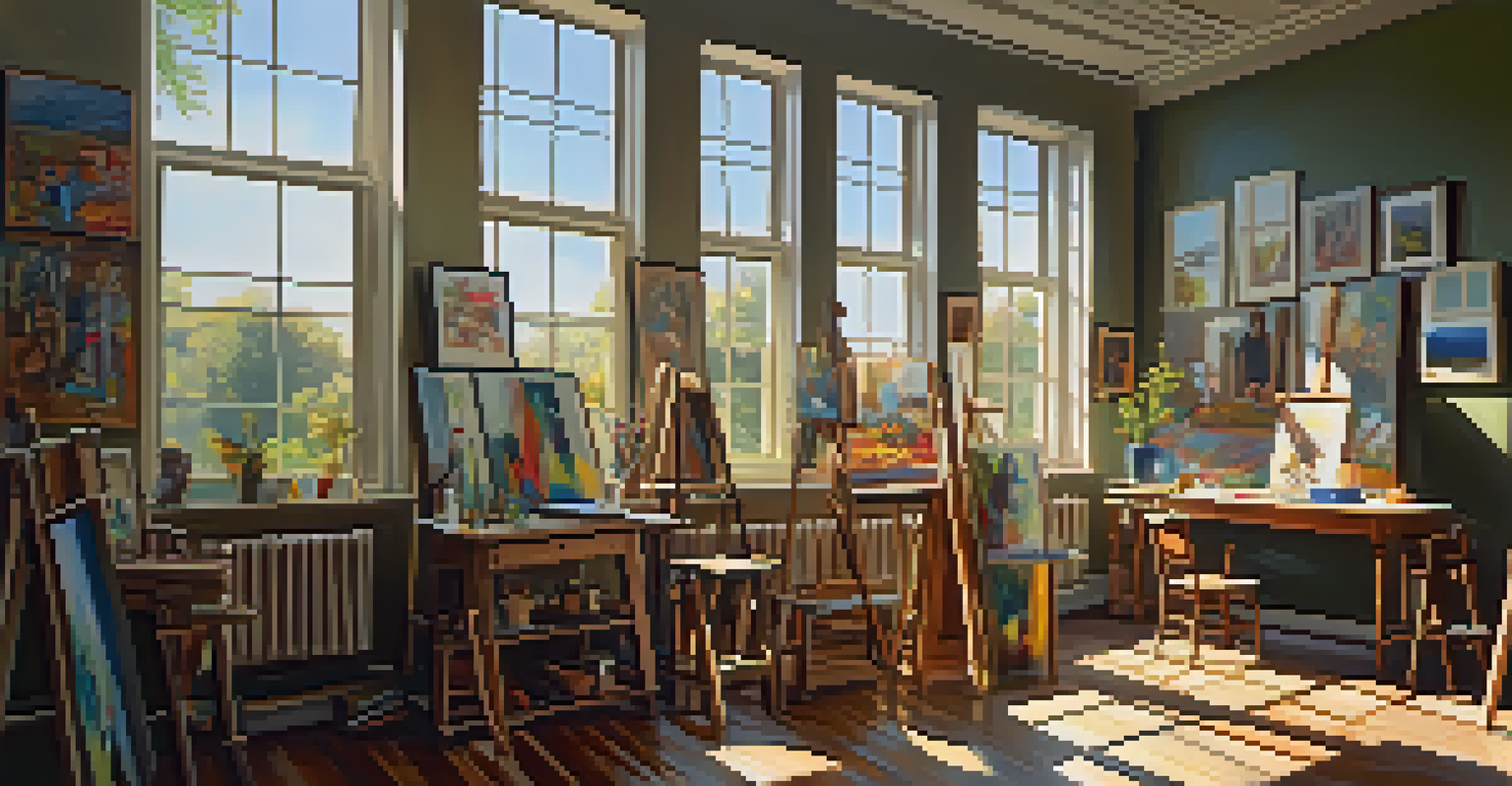Light and Shadow: Essential Elements in Painting Composition

The Role of Light in Painting Composition
Light is vital in painting as it creates mood and enhances depth. It can evoke emotions, guiding the viewer's feelings about the artwork. For instance, a bright, well-lit scene might convey happiness, while dim lighting can create a sense of mystery or tension.
Light is the magical ingredient that transforms the canvas into a living, breathing thing.
Artists often use light to highlight focal points, drawing the viewer's eye to specific areas of the canvas. This technique helps to narrate a story or emphasize an element within the painting. A classic example is Caravaggio’s use of chiaroscuro, where dramatic lighting accentuates the subjects' expressions.
Understanding how to manipulate light can significantly affect the viewer's perception and interpretation of the painting. By mastering light, artists can transform a flat surface into a dynamic visual experience that resonates with the audience.
Shadow: The Unsung Hero of Composition
While light often steals the show, shadows play an equally important role in composition. Shadows add depth and dimension, creating a sense of realism that makes the painting more relatable. Without shadows, a piece can appear flat and lifeless.

Consider how shadows can suggest the time of day or the mood of a scene. For instance, long, soft shadows in a sunset painting can evoke feelings of calm and nostalgia. Conversely, harsh, stark shadows in a stormy scene might introduce a sense of foreboding.
Light Sets the Mood in Art
Light plays a crucial role in evoking emotions and guiding the viewer's feelings about a painting.
Moreover, shadows can guide the viewer's gaze, leading them through the painting and emphasizing key elements. This subtle navigation helps maintain interest and engagement, making the artwork a more immersive experience.
Creating Contrast with Light and Shadow
The interplay between light and shadow creates contrast, which is essential in drawing attention and creating visual interest. By juxtaposing light and dark areas, artists can create a dynamic balance that captures the viewer’s eye. Think of how a bright object stands out against a dark background, making it the focal point.
Shadows are the soul of the painting, giving depth and emotion to the light.
This contrast can also serve to symbolize themes or emotions within the artwork. For example, a bright figure in a dark scene may represent hope amidst despair. Such symbolic use of light and shadow can deepen the viewer's understanding and emotional connection to the piece.
Furthermore, contrast can enhance the overall composition by guiding the viewer's journey through the artwork. By thoughtfully placing light and shadow, artists can control the viewer's attention, ensuring that the most important elements shine through.
The Emotional Impact of Light and Shadow
Light and shadow can evoke powerful emotions in the viewer, adding layers of complexity to a painting. For instance, warm light can create feelings of comfort and happiness, while cold shadows might induce a sense of sadness or isolation. This emotional resonance can greatly influence how a piece is received and interpreted.
Artists often exploit these emotional responses by choosing specific lighting conditions to convey their intended message. A painting illuminated by soft, golden light might evoke nostalgia, while stark, high-contrast shadows can evoke tension or conflict. Understanding these associations helps artists communicate more effectively.
Shadows Add Depth and Realism
Shadows are essential for creating depth and dimension, making artwork more relatable and engaging.
Ultimately, the emotional impact of light and shadow can transform a simple painting into a profound experience. When viewers connect emotionally with the artwork, it fosters a deeper appreciation and understanding of the artist's intention.
Techniques for Mastering Light and Shadow
To effectively harness light and shadow in painting, artists can employ various techniques. One common method is glazing, where transparent layers of paint are applied to create depth and luminosity. This technique allows for subtle transitions between light and shadow, enhancing the overall composition.
Another technique is the use of underpainting, which establishes the light and shadow structure before the final layers are added. This foundational step can help guide the artist's approach and ensure a cohesive balance throughout the painting.
Finally, studying the effects of natural light in different settings can greatly improve an artist's understanding of how to depict light and shadow. Observing how shadows change throughout the day can provide invaluable insights that can be applied to their work.
Light and Shadow in Different Artistic Styles
Different artistic styles interpret light and shadow in unique ways. For instance, Impressionists like Claude Monet often used quick brush strokes to capture the fleeting effects of light, resulting in vibrant, dynamic scenes. Their approach emphasizes the emotional experience of light rather than strict realism.
On the other hand, artists from the Baroque period, such as Rembrandt, utilized dramatic contrasts to create depth and emotion in their work. This technique, known as tenebrism, highlights the interplay of light and shadow to evoke a strong narrative presence.
Contrast Enhances Visual Interest
The interplay of light and shadow creates contrast, drawing attention and enhancing the overall composition.
Understanding how various styles utilize light and shadow can inspire artists to experiment with their techniques. By blending elements from different movements, they can develop a distinctive voice that resonates with their vision.
Conclusion: Embracing Light and Shadow in Your Art
In conclusion, light and shadow are essential elements that enrich painting composition. They bring depth, emotion, and narrative to the canvas, engaging viewers in a way that mere color cannot. By mastering these elements, artists can elevate their work and connect more deeply with their audience.
As you explore your artistic journey, remember to pay attention to how light and shadow interact in your surroundings. Observing the world around you can provide inspiration and insight into how to apply these techniques in your own work.

Ultimately, embracing the power of light and shadow can transform not just your paintings, but also your understanding of art as a whole. So grab your brushes and start experimenting—there’s a whole world of light and shadow waiting for you to discover!